December 11, 2010
Mesa State – premiere of Hymn to a Blue Hour
When I look at my photo library and the number of blog entries they should have generated this fall, I’m a little embarrassed. The blog updates have really suffered lately, because this blog seems to be the first thing neglected when I’m busy — and I’ve been busy, with residencies at Florida State, Texas A&M Corpus Christi, the University of Michigan (one of the few events that I managed to blog already), a surround-sound BluRay recording of “Kingfishers Catch Fire” at UT Austin, several rehearsals at Texas A&M, and we gut-remodeled two bathrooms at the house. Oh, and I wrote a piece. That piece, “Foundry” (for concert band with “found” percussion) will be the subject of future blog entries for sure. First, though, let’s go in order of most-recent-first, and talk about last week’s trip out to Mesa State College. (This is a big ol’ entry, but I promise that there are photos — just not until later in the entry. I didn’t take pictures at rehearsals, unfortunately, but how effective are pictures of the back of a conductor’s head?)
Mesa State College is a fairly small college in Grand Junction, which is in western Colorado. Although the school is small, the music department has found a way to host a significant band festival each year, called Best of the West. It features two high school honor bands (with kids from as far away as a 9-hour drive in northeastern Colorado!), both conducted by guest conductors, a guest artist (soloist), and a guest composer who is commissioned to write a piece for the college group (which also performs during the festival). How the hell does a small school, outside of any major city, afford such an undertaking?! Donors. Very, very supportive donors. We’ll get to them — or really, one wonderful donor — soon.
First, though, we need to fly to Grand Junction. You can’t fly there direct from Austin, so you need to connect in Denver. During my layover in Denver, I had to get my pointy boots shined, and I struck up a conversation with the shoeshine guy. “Hey, have you ever been to Grand Junction” I asked. “Oh, all the time. My girlfriend lives out there.” “Oh, cool. That’s where I’m heading today.” Long pause.
“Are you a… good flyer?”
“No, I’m a terrible flyer. I’m a composer, and I wrote a piece about my fear of flying. I suck at flying.”
“Oh. Uh… it’s gonna be a rough flight. I’d take a bunch of Dramamine. It’s a short flight, though. It’s only about 30 minutes. Don’t worry; there are about 3 minutes in the middle there, when you’re leveled off, that it’s not bad. Good luck.”
Good luck?! WTF. Thanks, buddy. (The shoes looked great, though. He used a torch – like, a creme brulee torch — on my shoes. It “opens the pores,” he said. It also made a scary smell, which was disconcerting, and I wondered if they had a fire extinguisher off to the side in case my feet burst into flames, but it all turned out just fine. And shiny.)
The takeoff out of Denver sucked, but flying out of Denver always sucks, since you’re climbing through the foothills at the base of the Rocky Mountains. The rest of the flight, even the landing, was just fine. So, shoe dude scared the shit out of me for nothing.
Grand Junction Airport is… small. No jetway here, my friend.
Calvin Hofer, the Mesa State College Director of Bands, picked me up at the airport, and we checked into my hotel, then met Anna Marie Wytko — the festival’s wonderful guest artist — for lunch. But more about Anna soon…
From there, it was off to Recital Hour, where a faculty quartet gave a nice performance of my piece, “Breakdown Tango.” It was fun hearing that piece live in person again. (For those who don’t know, it’s the original chamber ensemble version of “Redline Tango.”) Then, after a short break, it was time to rehearse with the band.
The wind ensemble was performing three (THREE!) of my pieces that week: “Sasparilla” (I swear, it’s the year of “Sasparilla.” It goes, like, four years with maybe three performances a year, and this year – bam, roughly a dozen performances, including with two different bands in Norway. Weird.), my Concerto for Soprano Sax (with Anna Marie Wytko, soloist), and the world premiere of “Hymn to a Blue Hour.” “Sasparilla” went great (they’ve been performing it since October, and rehearsing it since long before that). The concerto is friggin’ difficult, not just for the soloist but for the entire ensemble, but the players were working on it really hard (and Anna was pretty amazing), and it was coming together. Then there was “Hymn to a Blue Hour.”
I wrote about the creation of this piece during the summer, and it was amazing to hear it for the first time as played by the conductor and ensemble who commissioned it. The piece demands a somewhat excessive freedom of tempo in order to work well. I want it to be conducted like the most romantic interpretation of Mahler — and that’s difficult. Calvin Hofer was doing a beautiful job.
The next day, I had a composition master class with a very talented young composer named Sarah Strong. I can never imagine how a composer gets the courage to present their work for critique, publicly (in front of probably 40 people), to another composer. I don’t think I could do it. Sarah was very brave (and her music was really good!), and I want to thank her for subjecting herself to that. I had a nice time with Sarah, both in her master class, and in rehearsal, where she sat next to me and watched me frantically scribble on Post-It notes.
That night, Anna Marie Wytko gave a solo recital. Anna is the Assistant Professor of Saxophone at Kansas State, where she (obviously) runs the sax studio, and teaches things that my brain could never fully understand (like music theory). Her recital was pretty incredible. Beautiful tone and musicality, spot-on intonation, and she “feels” like a soloist. I don’t know quite how to explain what I mean there, but she’s one of those players who, when you watch and hear her perform, you’re like, “yeah, that’s a soloist.” Her program was varied, with everything from Baroque music to new works. My favorite piece was “Elegia” by a composer named Maciej Malecki (whom I’d never heard of). This was my favorite piece on the program in spite of it being for, um, solo saxophone. I mean no disrespect, but solo works for any solo monophonic instrument often bore me. (If this blog entry were a Facebook post, I would now expect 75 comments stating, “then you haven’t heard “X” for solo “Y!” I know, I know; there are exceptions.) I was riveted throughout Elegia, though, primarily because of Anna’s performance of it, and maybe because I guess it really wasn’t monophonic at all, since it was loaded with saxophone multiphonics.
The best part of the piece was the use of the piano pedals. See, the accompanist stayed on stage for the piece, and in certain places, would depress the sustain pedal while Anna would play things into the piano, causing the piano to sustain the notes that had been played into it. It’s an awesome trick, but of course it only works if you’re playing perfectly in tune. I’d never heard it done with multiphonics, but it was very, very cool.
Oh, and it was Anna’s idea. She added the piano pedal effects to the piece with the permission of the composer, but it was her idea to ask to do so. I wonder if Mr. Malecki has since revised his piece to include the effect. If not, he should; it’s the best part of the piece.
Early Friday morning, I met with the Music Industry class. This was the first time I’ve ever spoken to a business class — and it was a lot of fun. I sincerely enjoy the business part of what I do, but that element can rub people the wrong way. (“It ain’t art if you ain’t broke” is an attitude that drives me crazy.) It was a nice change to be able to talk just about the business side, which, honestly, is a lot easier for me to talk about than the creative part.
Okay – picture time!
Friday afternoon, I got a tour of the area from Karen Combs, the donor who funds this whole festival. She and her late husband, Stephen Boelter, started the festival ten years ago. (“Hymn to a Blue Hour” is dedicated to Stephen.) Karen is amazing. She is fun, and funny, and energetic. And wow, is she fit. I like to think I’m in reasonably good physical condition, but my hike with Karen made me think otherwise. (I’m going to blame the 5000 feet of altitude.) Karen drove me up to Cold Shivers Point, named so because you can walk up to the edge of this crazy cliff, look straight down 1500 feet, and get cold shivers. It was beautiful up there, but I did get a little vertigo.
I like this crazy dead tree.
Then we drove back down to the bottom and started a hike back up, heading towards something called Devil’s Kitchen.
We probably hiked for 40 minutes, and it became painfully clear why people in Colorado are said to be the most fit people in the country. I loved being out there, in the cool fresh air. When we got up to Devil’s Kitchen, way up high in the rock was this lone, tiny tree. How did that seed find the only patch of soil on this massive span of rock? Good job, little seed.
I’m not being freaky with the color. It really looks like this up there.
The concert that night went great. Of my pieces, they started with “Hymn to a Blue Hour,” and I was so proud of the students for what they accomplished with all of the pieces. Karen seemed happy, so I was happy, too.
The next afternoon, the high school honor bands gave their concert, and they performed “Undertow,” with guest conductor Eugene Corporon (Director of Bands at the University of North Texas) conducting. I had a fun time working with Mr. Corporon and the students, and the performance went really well.
With all of the concerts complete, it was PARTY. TIME.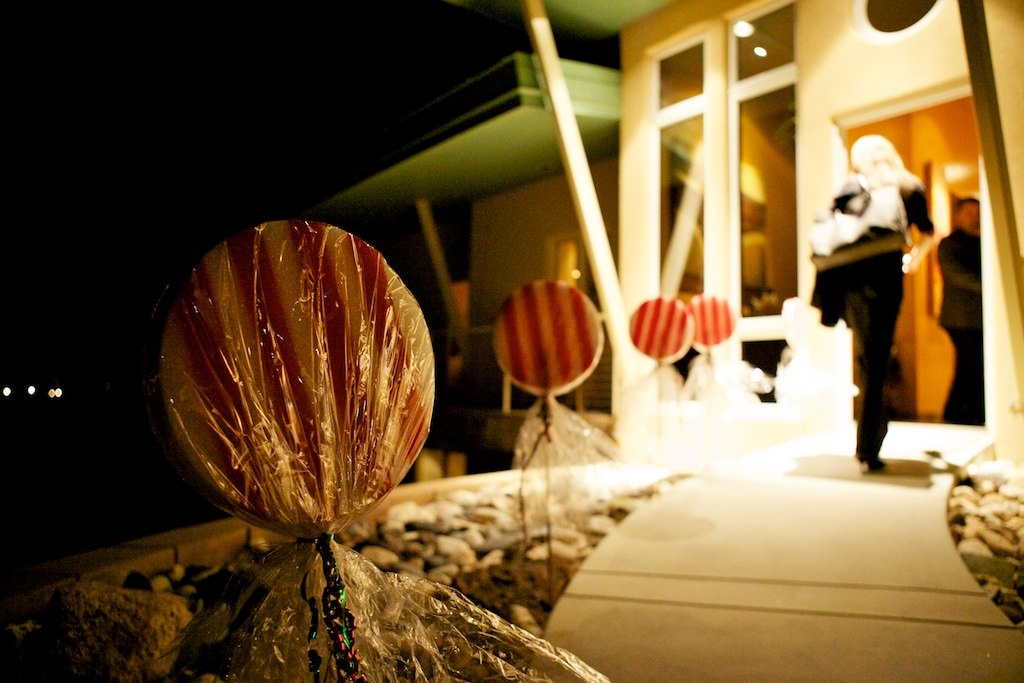
Karen hosted the party at her home, which was designed by Stephen, who had been a successful architect. The house is, simply put, stunning. As should be pretty clear, if you’ve read this blog for long, I love design. (Just click those “design” links on the left!) What Stephen accomplished, with Karen’s help, is something that I can’t really describe, nor could I photograph it well. (I was kicking myself for not bringing my ultra-wide-angle lens.) Although I never met Stephen, now that I’ve met so many of his friends who loved him, and I had the honor of spending several hours in the home that he designed for himself and his wife, I feel like I do know him, just a little. Here’s a shot of an architectural model of the house that Stephen initially designed for them. They didn’t build this (Karen didn’t love it, so Stephen started over, and what they did build is even better), but it’s a pretty picture (and I love architectural models).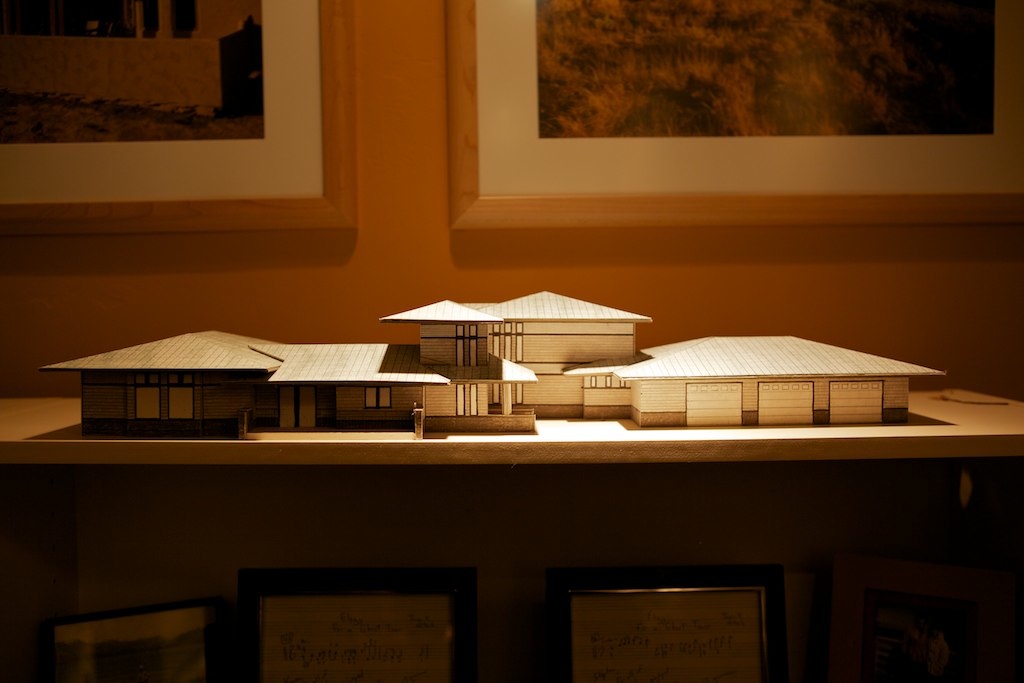
The house is loaded with great art, but my favorite piece had to be Clarinet Person. (That’s not the title of the piece, I’m sure, but I choose to call it Clarinet Person. You can see why. Stephen was a clarinetist.)
The party was fun, and at the end, Karen brought out her big closer: a bottle of pear brandy.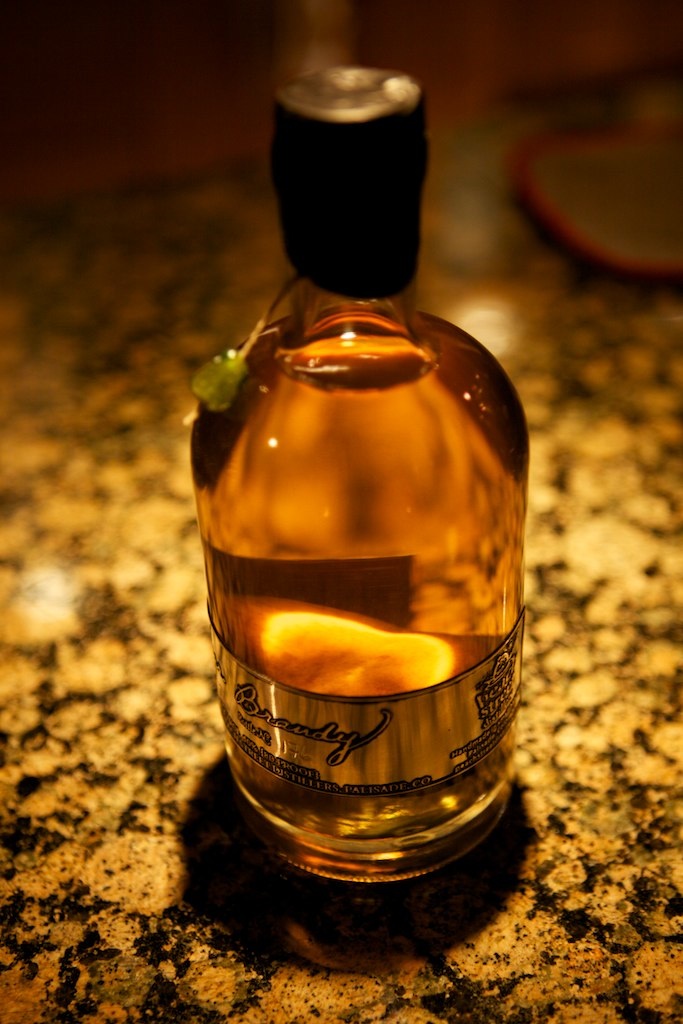
Yes, that’s a bottle of brandy with a pear in it. It’s like magic! It’s like a ship in a bottle, only eatable, drinkable, and with liquor!
The brandy was tasty (with a definite pear note), but then we had a bottle with a pear stuck in it.
Calvin took the bottle out to the garage, found a hammer, and busted the bottle open.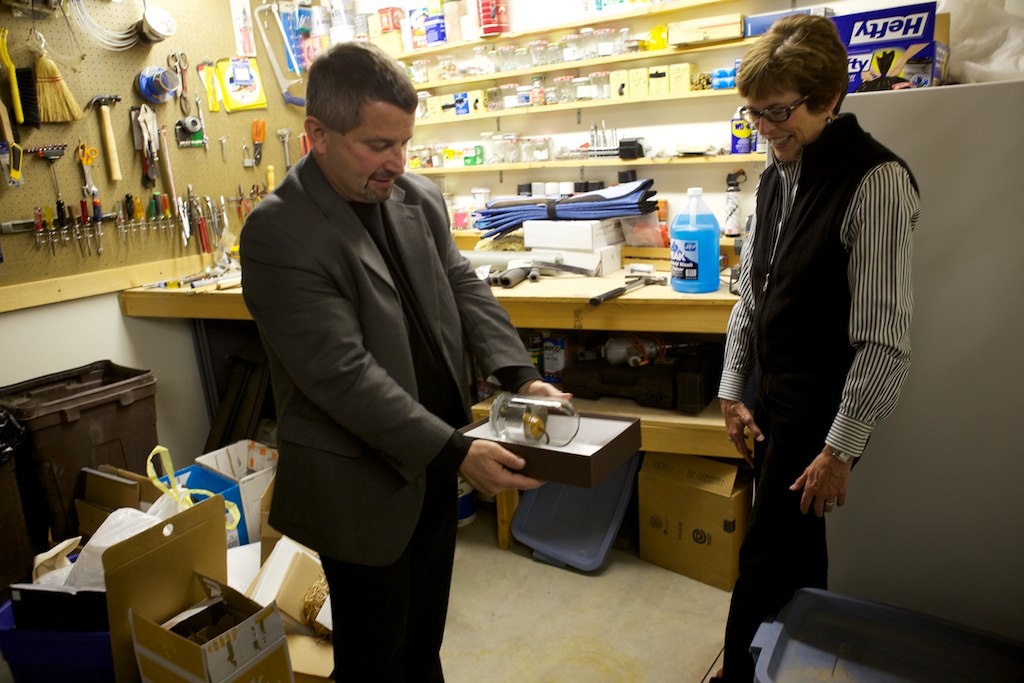
Okay… now what?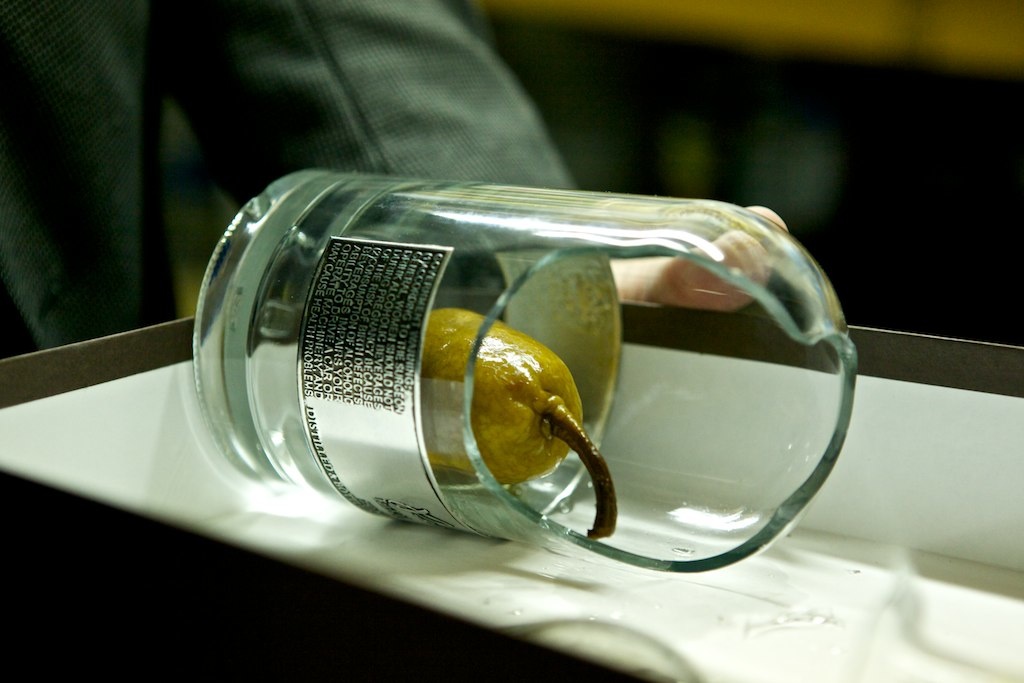
I call this work, “Brandied Pear Still Life.”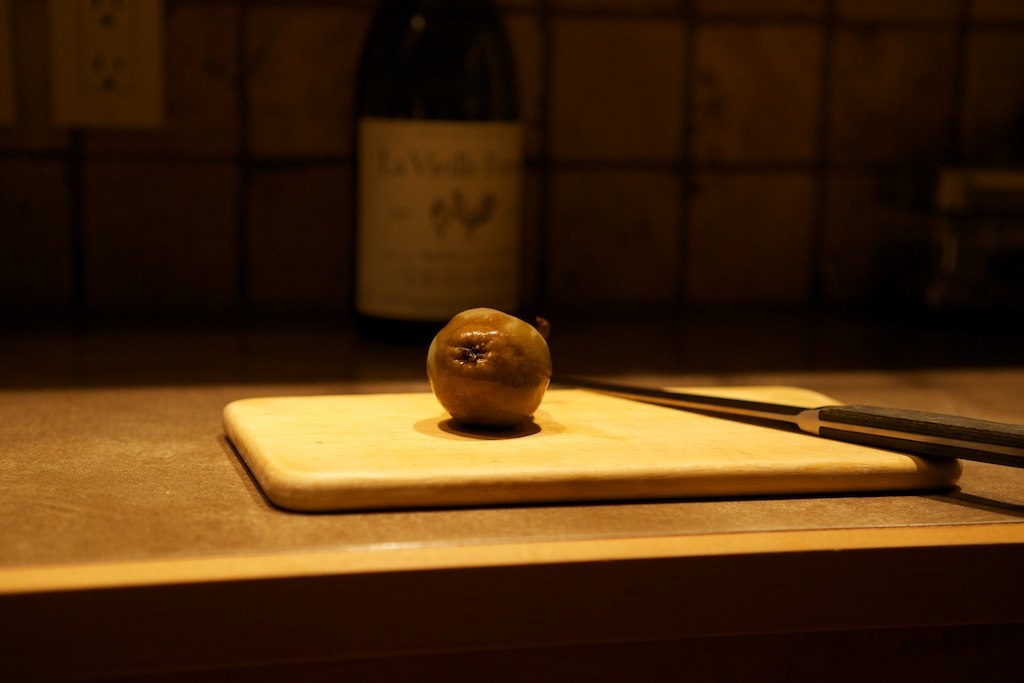
Karen assigned Anna the task of slicing the pear. (Anna seemed convinced she was going to cut off a finger. Fortunately, she did not. I suspect it’s difficult to play the saxophone with missing fingers.)
It turns out that brandy-soaked pear is… not very good. I expected a soft texture, like a canned pear, but it was very hard, not very pear-like, and strongly alcoholic. I’m told that I made a horrible, pained face when eating my piece, but happily there are no pictures of said face.
This was one of the more memorable residencies I’ve had the honor to participate in. I can’t thank the students enough for all of their hard work on a lot of very difficult music — and I’ve rarely been made to feel so welcome. Here, left to right, are the people who made it possible: Calvin Hofer, Sara Wynes (who conducted the other high school honor band), Anna Marie Wytko, Karen Combs, Eugene Corporon, and some Euro-looking elf.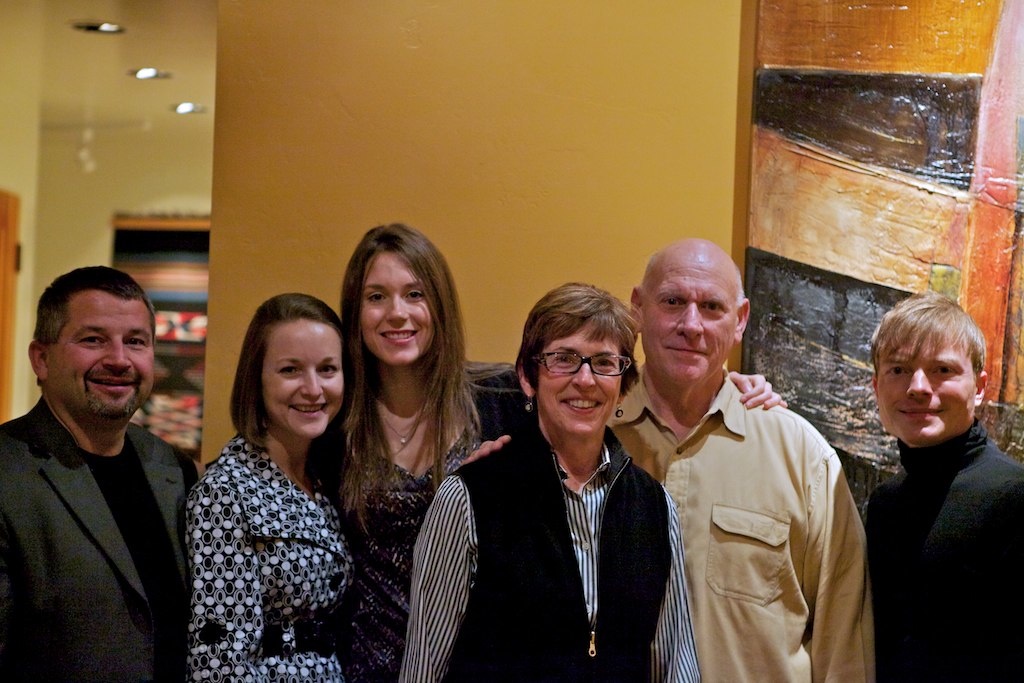
Next up: the Midwest Clinic in Chicago, where, among other performances, Texas A&M will perform “Hymn to a Blue Hour” on Friday at 5:30pm. Karen Combs is flying in for the performance. No pressure…
November 14, 2010
Grade 3 = difficult
I’m chugging away on a new piece — a piece for young bands (like, middle school band). In “the biz” (I’ve always wanted to use the wonderfully-pretentious term “the biz”), this level of music is called a “Grade 3.” There are either five or six grade levels — depending on whom you ask — that indicate level of difficulty. A Grade 1 piece would be for players who can play a Bb (I don’t mean they can play in Bb, I mean they can play a Bb); a Grade 6 would be something like “Turbine.” (After hearing Steve Bryant’s new “Concerto for Wind Ensemble” — perhaps the most difficult work I’ve ever heard for winds — I think somebody is going to have to allow a new Grade 7 ranking.)
I tried writing a Grade 3 piece about a year ago, and I failed miserably. I put it in an awful key (A minor), and even though it was all in 4/4, there was so much dissonance that I think it was pretty much impossible to ever get a middle school band to play the thing in tune. (I don’t know for sure; I’ve never actually heard a recording of the piece, and I probably never will, as I won’t be releasing the piece.) The whole thing ended up sounding like a dirge — and writing it was a real slog, so it’s not surprising that the end result ended up as such a downer.
Well, I’m at it again. The new piece (like most of my music) comes from an idea of AEJ’s. She thought it would be an exciting revelation for a percussionist when they first realize that they aren’t limited to playing snare drum and bass drum and cymbals. At some point, they’ll actually be expected to find non-traditional instruments, too. Why not write a piece for young players that’s designed to introduce percussionists to that reality? A piece with lots of “found” percussion.
Initially, I was going to be specific about what I wanted the players to find, but a few weeks ago, I read about an old piece by Magnus Lindberg. Lindberg, in his orchestra piece, “Kraft,” describes sounds that the percussionists must produce, but doesn’t tell the players exactly how to make those sounds. The players are directed to find materials (often at a junk yard), and every performance of the piece will sound a little different because the instruments will be different.
I’m going to go kind of midway on that. I’m going to describe what kinds of sounds I want (“a metallic ‘clang,’ with quick decay”), but I’ll also give a specific example of an “instrument” that might produce the sound I’m after (“such as a brake drum with a heavy piece of metal on top”). Hopefully the players will be creative enough to try to find alternatives, but if creativity isn’t their thing, they can use my example.
The result, so far, sounds like a simpler version of “Asphalt Cocktail” (perhaps a “Virgin Cocktail?”), but as performed in a machine shop. It’s HVAC duct parts, pans, a box cheese grater (or a guiro, if you must), and steel rails and pipes, all with power chords on top. It can be played by anywhere from 8-12 percussionists.
The biggest challenge in writing music for young bands is writing music that easy, but it doesn’t sound simplistic or dorky. It still needs to sound like I wrote it, but it needs to sound like the piece just happened to be technically easy — as if it happened by accident. (“Oops! I accidentally wrote an easy piece! How did that happen?”) I think it’s turning out pretty well this time around, but we’ll see how difficult the piece turns out once it’s done. So far, it’s all in 4/4, just about entirely diatonic in G Minor (looks like Bb major!), and with nothing faster than an 8th-note.
On Facebook this morning, I mentioned the difficulty associated with writing “easy” music. (It’s appropriate that I’m discussing the process on Facebook, since I funded this entire commission via a consortium organized through a Facebook post.) In response to my post, fellow-composer Bruce Richardson wrote the following response:
Easy music is a trap, because it’s the hardest to play. There isn’t really even any such thing as easy music. That’s why most times a decent high school band will sound semi-good playing upper grade literature, and will utterly fold on something like Elsa’s Procession.
Basic craft aside, getting one’s voice on paper requires a suspension of consideration for the player. The player must also suspend a certain amount of consideration for the score, because a true player expresses only himself, through the vehicle of a piece.
When you’re dealing with people who write well, and play well, this synergy results in the uplifting of both player and composer. The composer hears his idea taking birth, that is, developing a life of its own he could not have conceived. The player is programmed at a basic level by the composition, but then enters the realm of performance and risk, and makes split second decisions along the way that result in performances we call “inspired,” that is, transcending what anyone, including the player, could have intended.
So, when you’re applying an artificial construct (in this case, music education) to that composer/player agreement, it changes everything. That’s where things get trite, because it makes the composer’s job different. Do you write a pure piece that might be hard, and pixelate it in a manner of speaking? Certainly that’s how orchestral reductions are handled at times, and it works to a degree.
I would speculate that perhaps the most useful Grade 3 pieces would be written in such a way that they “hook” the technical and emotional ability of the player of that age, so that with the tools he has, he can perform the music the same way a professional does…by taking his current toolset, and plunging into the act of musicmaking.
That’s why I’m always a little sad to hear some superhuman middle school band playing the Persichetti symphony, or Lincolnshire Posy. To borrow a phrase, it doesn’t smell like teen spirit.
So, there’s the challenge: taking the “current toolset” a young player possesses, and giving them material that allows the player to make actual music. Jeez, good luck. I don’t know if I’ll reach that lofty goal, but whatever happens, we’ll know around December 1. That’s my deadline.
Staying on deadline will be tough. We discovered “Dexter” about a week ago, and have already watched two full seasons. Season 3 comes via Netflix tomorrow. I’d better get back to writing before the mail comes…
View Comments
Comments
so great that a wonderful composer is targeting young players in this way--if anyone can do this, its you. looking forward to hearing what you come up with!
S and I just rented Season 1 of Dexter about ten minutes ago. Weird. This is after working our way through the first 2 seasons of Breaking Bad this past week. If it wasn't for TV on DVD, I'd probably have a PhD by now.
Other obstacles I've encountered in writing "Grade 3" music:
1) part independence
2) thin scoring
3) lack of physical stamina to produce true "ppp" and "fff" dynamics with control, which limits the sort of drama in music that you and I both gravitate toward.
I think 1) and 2) scare the directors more than the players, and are the reasons my "Grade 3" works (Dusk, Marbled Midnight Mile, etc.) are labeled grade 4.
I hope you don't water down your signature rhythmic vitality, though - I think young players can grasp rhythm quickly and intuitively. Given the percussion focus of this (which is a fantastic idea, btw), I say go to town rhythmically. Just don't write 30+ high C's for the Horn section...
I've always felt that writing so-called "easy" music is not only one of the most difficult jobs for a composer, but also a true test of a composer's skill. I feel fortunate to have had the opportunity to do this on a yearly basis, which really honed my writing chops. I'm currently in the middle of writing yet another middle school band piece, so I feel your pain, John.
But writing for young ensembles can also be a great proving ground for compositional ideas. I often use middle school pieces as a way to test out a compositional idea or train of thought before I apply it to a more difficult piece. If I can make it work in a Grade 2 or Grade 3 piece, then I know it's a viable idea.
I'd also like to echo Steve's comments. He's spot-on with his list of obstacles. The percussion focus IS a fantastic idea, though. In fact, that's the direction I was heading with my current project, but it sounds like you beat me to it. Oh well, time for Plan B, I guess.....
Steve- as always, correct!
John, related to your comment on FB about why there's so much crap band music at this level: it is very simple, actually. Name a composer that churns out garbage music at the "lower" grade levels and I 'll show you a bad composer. The problem is that the market for this type of music is slick and unsophisticated because all that is needed is a.) dorian mode b.) syncopation, and c.) a lengthy program note.
That becomes the beginning and end of the compositional craft. It makes it easy for some teachers - they don't have to deal with teaching music - and it makes it fun without much effort for students - which is a positive for them in the short term. That's why the stuff sells so well.
One of the reason you guys (and I define that as you, Steve, John, Jim, and anyone else that fits the bill) have been very successful is because you did not learn to compose music by cranking out crap grade 2 pieces that are based more on programatic elements rather than viable compositional craft. You guys became great composers AND THEN (as several have commented) decided to tackle the issue of creating a work of substantial quality with specific technical limitations. I wrote in an article a while back that there is most definitely a difference between great music that happens to be technically simple and music that initially sets out to be "easy."
The reason why your "grade 3" (whatever THAT is) will be good? Because you can write a "good" grade 6. The composer that specialize in grade 3 music that write a grade 6...it's the same crap music but with 16th notes and an extra octave.
Cheers!
Ken Thompson
College of Musical Arts
Bowling Green State University
Detroit Symphony Orchestra Civic Ensembles
Toledo Symphony Youth Orchestras
I find writing grade 3 extremely challenging for all of the reason's stated above. My only Grade 3 is a 4 for sure. I find this is difficult because your creative mind whirls with sound and have to find a way for those sounds to translate to a technically easier notation.
I have been slammed at times by critics because most of my works called Grade 3 are usually commissioned by middle level high- school bands.
My mind however dreams that it is the MSU/UM/UT ensemble and then suffer with finding ways to write what the mind's ear wants and then how to notate this and teach that concept to both the students and school directors.
This has lead me to write out clusters rather than temporal notation, carefully place meters changes, be attune to ranges and woodwinds going quickly over the break etc. Have I succeeded? In my opinion yes, however my oldest Grade 3 gets more play than any other work. It was composed in a more traditional style.
I think you should write what you hear just keep in mind what a 7th grader needs to experience success. Dissonance should not be a problem, its not hard to execute, its hard to sell to this age of student. Their emotional level and life experience do not lend well to certain concepts. BUT This can be achieved with the right person swinging the stick and how much collaboration they have with YOU.
Remember not every work in certain band series at a grade 3 is a hit and some are frankly disappointing.
The commissioning party wants a Mackey, because they love your other music and want to share it with younger students. That in itself is a great compliment!!
I applaud and echo Ken Thompson's comments. He is quite insightful.
John you should talk (and I'm sure you already have) to some middle school band directors, ask them to tell you some of their favorite grade 2 and 3 tunes, and get some scores and recordings. Even some of those guys who churn them out by the bucketload have some diamonds in the rough- I would use Michael Sweeney's "Beyond the Seven Hills" or "Ancient Voices" and Elliot Del Borgo's "Chant Rituals" as examples. I think that any time you are struggling with something, part of the solution is usually to go ahead and learn from the masters. Maybe you can pick up a scoring or motivic or some other idea from Pierre La Plante, Brian Balmages, or one of those guys. As a middle school band director at a school where grade 3 is out of our reach many years, I can tell you that I have a very eclectic list of pieces I really think are very musical and do a fantastic job of handling young players' needs. I would send you first to Timothy Broege's "Train Heading West." That piece is more genuine and musical than a lot of college band music I hear these days, and is no harder than a solid grade 2.
I'm not a composer, director, or music educator, so I don't have any technical or professional advice to share. However, it would seem to me that one important aspect of writing successful music for kids playing at this level is to respect and honor what they *can* do with their instruments rather than focusing on what they can't do.
Another thing I've noticed about kids and music is that they're so focused on technique (How do I finger this note? Did I tongue it just right? Am I going the right speed? Good lord--that sounds like my first boyfriend!) that they have no musicality whatsoever. But every once in awhile a piece will speak to them so viscerally with a simple emotion (Joy! Sadness! Anger!) that they're able to overcome the technicalities and play the MUSIC. It's a miracle when that happens. John, your music does this for players and listeners alike, so I think you've got a good shot at a successful piece.
Hello.
My name is Mary Ann Evans.
I'm in the Willow Wood Honor Band at Willow Wood Junior High.
Your writing the piece for our concert :)
I play bassoon (first chair... I'm not bragging).
I am making a suggestion. It would be soo amazing if you could put a bassoon solo in the piece, because I play amazingly loud with an amazing tone and amazing quality (not bragging just telling). I just want to be heard from the audience and have an "important part" for once. But of course I'm just suggesting.
Thank You for writing a piece for my band.
Your Awesome :),
Mary Ann Evans :P
I feel so much better after reading your "Dexter" comment. Why is it that, as soon as I have a compositional deadline to meet, I discover some new series on Netflix or a new cuisine that I've just got to master? Right now, as I should be working on this vocal quartet, I'm ordering MORE remastered Star Trek Original Series episodes on Netflix, knowing that it only means more 3am worknights at some point to get the piece done. Maybe without the procrastination, the piece wouldn't be as good. (I like to think so.) Good luck with the new piece!
Percy Grainger is one composer who definitely figured out how to write like that (and he just did it naturally, without having to "dumb himself down" as it were). Shepherd's Hey and Colonial Song are both some of the greatest pieces ever and are borderline Grade 3/Grade 4 in difficulty.
Fisher Tull is another good example....but I think a more familiar name of someone who's amazing at this is Frank Ticheli. If he'd just made American Elegy a little shorter I'll bet it could have passed as a Grade 3 on the UIL PML. American Elegy is more musically fulfilling than most Grade 5/6s.
I think it's all about finding a really simple, catchy motif and trying to develop it further in context, and not milk the crap out of it like some composers have ("Tempered Steel" comes to mind here....though I LOVE me some Tempered Steel).
when will the audio for this song be released (on the website)?
Add comment
November 9, 2010
Harvest – studio recording coming Friday
Wow, I have not been a good blogger at all. We’ve been renovating both bathrooms here at the house for the past five weeks, and that’s been all-consuming. (Pictures soon, of course.) Things are returning to normal now — the renovations were completed yesterday — and I have a lot of blogging to catch up on (plus, a new Grade 3 piece to write). Briefly, though, I wanted to announce that I’m finally posting the studio recording of “Harvest: Concerto for Trombone” this Friday, November 12, at 12:00 EST. The recording — with New York Philharmonic Principal Trombonist Joseph Alessi, soloing with the West Point Band, conducted by Timothy Holtan — is, well, insanely fantastic.
You’ll see.
Check this page on Friday at noon.
View Comments
Comments
Wonderful recording! Worth the wait.
This better be coming out on CD. I cried...I raged...I laughed....this piece has it all. I can't wait to blast this, you have no idea.
Great recording! Will we ever get to see a blog about your trip to Tallahassee?
View Comments
Comments
Calvin Hofer says
Wow John, after reading your blog, no wonder I was exhausted this past week! Everyone I talk to (my students, our faculty, the high school directors and their students) are still on a high from Best of the West. Thank you for being there, and thank you for being such a wonderful inspiration to all who attended BOTW 2010. And finally, thank you for composing "Hymn to a Blue Hour". It is a most stunning piece of music. Calvin
Karl Boelter says
Hi Mr. Mackey,
I sure enjoyed reading this entry. I’m Stephen’s kid brother. I participated in BOTW several years ago and, of course, have spent many occasions in Grand Junction with Stephen and Karen. Your story took me there, and I am so glad that you found the experience welcoming and successful. Congratulations on the new piece. I’ve heard many good things about it. It’s nice when you can work your tail off and be rewarded by a celebration in great style. (When I was there, though, we didn’t have any lollipops leading to the front door.)
Karl Boelter
Zach Childress says
It was an honour meeting you and working with you, Mr. Mackey. I had a great time at BoTW and loved playing Undertow. I can't wait for the next chance to work with you.
S. Strong says
You know. . . every time I start getting depressed or frustrated with my music I read this blog entry. Just saying.
Add comment